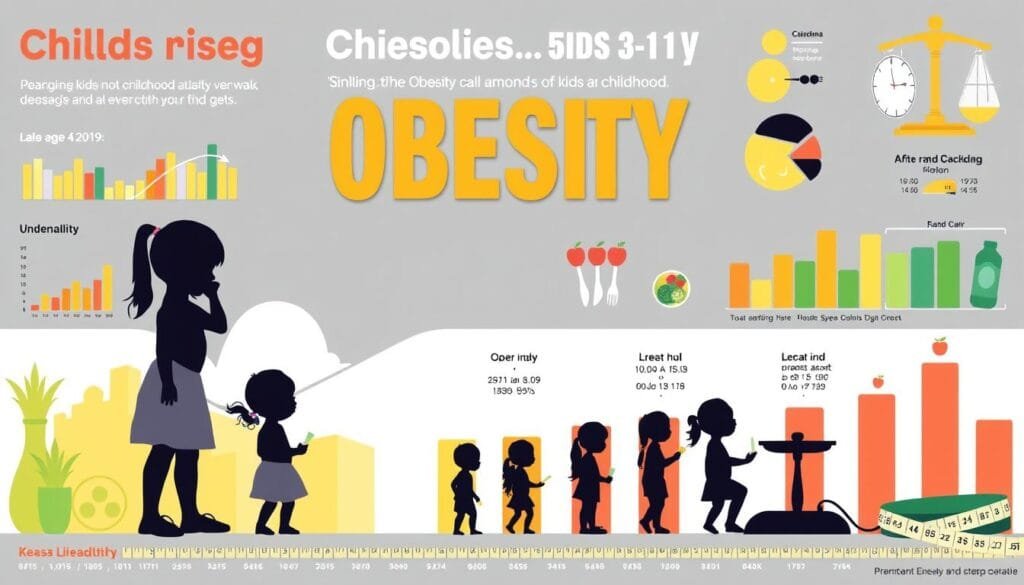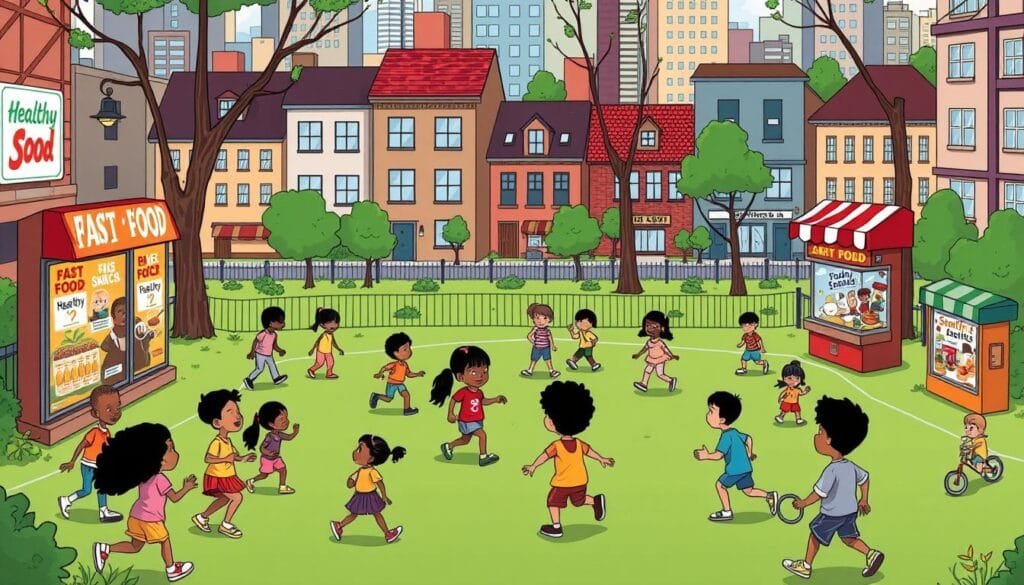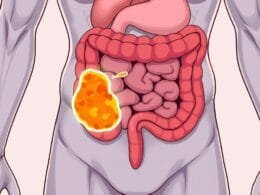Have you ever wondered why obesity is rising so fast in kids aged 2 to 19? About 1 in 5 U.S. children are now obese. This is a big problem for public health. The rise in obesity rates shows we need to look deeper into why it’s happening.
Many think it’s just about diet and exercise. But it’s more complex. It involves genetics and how much money families have. This article will explore the childhood obesity statistics and the many factors that play a part.
Key Takeaways
- Nearly 20% of U.S. children aged 2 to 19 are classified as obese.
- Obesity rates have tripled in the last 40 years.
- The COVID-19 pandemic made kids watch more screens and gain weight.
- Things around us and how much money families have affect obesity in kids.
- Knowing the causes is key to stopping obesity in children.
Understanding Childhood Obesity
It’s vital for parents and society to understand childhood obesity. We need to know what it is and why it’s becoming more common. This knowledge helps us tackle the issue of health and wellness in kids.
Definition and Prevalence
The definition of childhood obesity is when a child’s BMI is over the 95th percentile for their age and sex. In the U.S., about 19.7% of kids, or 14.7 million, are obese. This is a big concern.
Looking at childhood obesity prevalence by age group gives us a clearer picture. Here are some key points:
| Age Group | Obesity Prevalence |
|---|---|
| 2-5 years | 12.7% |
| 6-11 years | 20.7% |
| 12-19 years | 22.2% |
The numbers show a serious problem. Hispanic children have the highest rate at 26.2%, followed by non-Hispanic Black children at 24.8%. These numbers show how social factors play a big role in childhood obesity.
Statistics on Childhood Obesity
Childhood obesity is a serious public health issue. Knowing the current rates helps us find ways to stop it. The 2017–2018 National Health and Nutrition Examination Survey (NHANES) found that about 19.3% of U.S. kids aged 2–19 had obesity. Another 16.1% were overweight.
This shows a big health problem. It’s getting worse over time.
Current Rates
One in five kids in the U.S. has obesity, affecting over 14.7 million. The obesity rate among kids and teens was about 19.7% from 2017 to 2020. There are big differences in obesity rates by age:
| Age Group | Obesity Rate |
|---|---|
| 2–5 years | 12.7% |
| 6–11 years | 20.7% |
| 12–19 years | 22.2% |
There are big racial differences in obesity rates among kids. Hispanic kids have a rate of 26.2%, followed by Black kids at 24.8%. White kids have a rate of 16.6%, and Asian kids have a rate of 9.0%.
Income also plays a big role. Kids from lower-income families have an obesity rate of 18.9%. Kids from higher-income families have a rate of 10.9%. Boys are more likely to be obese than girls, with 21% of boys obese compared to 18% of girls.
Why There Is a Growing Trend of Obesity in Kids Aged 2-19?
Obesity in kids and teens is a complex issue. It involves genetics and environmental factors. Knowing these can help us understand why obesity is on the rise in the U.S. and worldwide.
Genetic Factors
Genetics are a big part of obesity. Kids with a family history of obesity are more likely to gain weight. This is because they might inherit traits that make it harder to manage weight.
Having obese parents or siblings can affect a child’s eating and exercise habits. This can lead to obesity, as genetics and lifestyle choices combine.
Environmental Influences
Environmental factors also play a big role in obesity in kids. Eating too much processed food and not enough exercise can lead to weight gain. Screen time, like watching TV or playing video games, makes kids less active.
Marketing unhealthy foods also affects kids’ eating habits. This makes it hard for families to choose healthy foods. In areas where healthy food is hard to find, obesity risks go up.
These environmental and genetic factors together explain the rise in obesity rates. It’s important to understand these to fight childhood obesity.
Impact of Sedentary Lifestyle on Childhood Obesity
A sedentary lifestyle impact is clear in today’s kids. They spend a lot of time watching TV, playing video games, and surfing the web. This sedentary lifestyle is a big part of the childhood obesity epidemic. The rise in screen time has led to more overweight and obese kids.
Numbers show a sad truth: overweight kids aged 6–11 have doubled, and teens aged 12-17 have tripled from the 1970s to the 2000s. This shows a strong link between sedentary behavior and obesity. The Centers for Disease Control and Prevention say about 14-15% of 15-year-olds in the U.S. are obese. This shows unhealthy lifestyle choices in today’s youth.
With more digital fun, kids watch screens almost four hours a day now, up from before the COVID-19 pandemic. Activities that don’t get kids moving increase the risk of chronic health problems. Kids who are overweight face physical and emotional health issues as they get older.
We need to tackle this problem in many ways, like getting kids to move more and watch less screen. Knowing how sedentary lifestyle impact works helps us find ways to fight childhood obesity.
| Age Group | Percentage of Obese Children | Impact of Sedentary Activities |
|---|---|---|
| 2-5 years | >30% | Increased screen time |
| 6-11 years | 23% | Decreased physical activity |
| 12-17 years | >22% | Higher fast food consumption |
Understanding how sedentary behavior and obesity connect is key to stopping childhood obesity. This helps us work towards healthier lives for kids.
Social Determinants of Health and Childhood Obesity
The social determinants of health play a big role in childhood obesity in the United States. Things like economic stability, education, and access to healthy foods shape family habits. Knowing these factors is key to fighting childhood obesity.
Access to Healthy Foods
Getting to healthy foods is a big deal for fighting childhood obesity. Families in areas with few grocery stores struggle to eat well. They often turn to fast food and convenience stores, which are bad for health.
This limited access leads to unhealthy eating habits. It makes it more likely for kids to become obese.
Community and Support Systems
Support from the community, like schools and local groups, is vital. Programs that teach about nutrition and encourage exercise are essential. They help kids make better food choices.
Communities with places for kids to play and exercise help fight obesity. Strong social networks and community involvement are key to a healthy lifestyle.
| Factor | Description | Impact on Childhood Obesity |
|---|---|---|
| Access to Healthy Foods | Availability of grocery stores with fresh produce. | Increased reliance on unhealthy food options. |
| Community Programs | Nutritional education and physical activity initiatives. | Promotes healthier eating and active lifestyles. |
| Socioeconomic Status | Income levels affecting food choices. | Higher obesity risk among low-income families. |
| Social Support | Community engagement in health initiatives. | Encourages children to adopt healthier habits. |
Childhood Obesity Health Risks
It’s vital to know the health risks of childhood obesity. This issue can cause serious physical problems and affect mental health. It’s not just about being overweight; it’s about the dangers it brings.
Physical Health Complications
Children with obesity face many physical health issues. These include:
- Increased risk of type 2 diabetes due to insulin resistance.
- Higher chances of developing heart disease from elevated blood pressure and cholesterol levels.
- Joint problems stemming from excess weight putting strain on skeletal structures.
- Potential for sleep apnea, which affects breathing patterns during sleep.
These risks can have serious long-term effects if not treated early. It’s important to prevent and treat these issues to help children stay healthy.
Mental Health Implications
Childhood obesity also affects mental health. Many children experience:
- Low self-esteem directly tied to body image issues.
- Bullying from peers, which exacerbates feelings of isolation and inadequacy.
- Increased risk of developing depression and anxiety due to societal stigma surrounding obesity.
So, tackling childhood obesity needs a complete approach. It must address both physical and mental health. This understanding helps families and communities work towards a healthier future.
Obesity Prevention Strategies for Children
Combating childhood obesity needs a full plan. It’s key to focus on preventing obesity in kids early on. Nutrition and physical activity are two main areas to focus on.
Tackling Obesity Through Nutrition
Teaching kids about healthy eating is vital. It helps them develop good habits. They should eat lots of fruits, veggies, and whole grains. Try to cut down on sugary drinks.
Knowing how diet affects health is important. It helps families make better choices. Adding healthy snacks and meals to their day is a great start.
Encouraging Physical Activity
Getting kids to move is also important. Active kids are less likely to be overweight. Activities like sports, dance, or playing outside are great for their health.
Schools and communities can help a lot. They can offer safe places for kids to be active. This helps make fitness a part of their daily lives.
Childhood Obesity Awareness and Education
Awareness and education are key in fighting childhood obesity. Schools and communities must work together to prevent obesity. By teaching kids about nutrition and exercise, we can help them make better choices.
Role of Schools and Communities
Schools are important in the battle against childhood obesity. They teach kids about healthy eating and the need for exercise. Community programs help by providing resources and support, reaching kids in different places.
Importance of Family Involvement
Family involvement greatly affects a child’s health habits. When families join in health activities, they support what kids learn at school. A healthy home environment helps kids stay fit and strong against obesity.
Getting families involved in education programs is key. It ensures kids hear the same messages about eating right and staying active.
| Group | Obesity Prevalence (%) | Commentary |
|---|---|---|
| Hispanic Children | 26.2 | Highest obesity rate among children in the U.S. |
| Black Children | 24.8 | Significant concern for health risk factors. |
| Non-Hispanic White Children | 16.6 | Lower prevalence, yet a concern. |
| Asian-American Children | 9 | Lowest obesity prevalence among these groups. |
| Children Aged 2-19 | 31.7 (Overweight) | Addressing obesity trends essential for future health. |
By working together, schools, communities, and families can help kids live healthier lives. This teamwork is essential for a healthier future for everyone.
Conclusion
Obesity in kids aged 2-19 is a big public health problem that needs quick action. The numbers show that obesity in preschoolers went from 5.0% in the 1970s to 10% in 2008. School kids (ages 6-11) saw obesity rates jump from 6.5% to 19.6%. And for teens (12-19), obesity rates went from 5.0% to 18.1%.
This shows we must act fast to stop obesity. We need good ways to prevent it.
To help your kids stay healthy, it’s key to know why obesity happens. Things like where we live, what we eat, how active we are, and our genes play a part. Parents, teachers, and communities must help kids make better choices. This means eating right and moving more.
By working together, we can make a big difference. We can help our kids stay healthy and avoid obesity problems later on.
In the end, working together is key to fighting childhood obesity. Families, schools, and doctors must join forces. This way, we can make sure our kids have a healthy future. We can help them stay well for their whole lives.
FAQ
What is childhood obesity?
What are the current statistics on childhood obesity?
Why is there a growing trend of obesity in kids aged 2-19?
How does a sedentary lifestyle impact childhood obesity?
What are the health risks associated with childhood obesity?
What strategies can be used to prevent obesity in children?
What role do schools and communities play in raising awareness about childhood obesity?
How can family involvement influence childhood obesity prevention?
Source Links
- Childhood obesity: a growing pandemic – https://www.ncbi.nlm.nih.gov/pmc/articles/PMC9765420/
- State of Obesity 2023: Better Policies for a Healthier America – TFAH – https://www.tfah.org/report-details/state-of-obesity-2023/
- What Causes Childhood Obesity? – https://my.clevelandclinic.org/health/diseases/9467-obesity-in-children
- Childhood Obesity Facts – https://www.cdc.gov/obesity/php/data-research/childhood-obesity-facts.html
- Childhood and Adolescent Obesity in the United States: A Public Health Concern – https://www.ncbi.nlm.nih.gov/pmc/articles/PMC6887808/
- Products – Health E Stats – https://www.cdc.gov/nchs/data/hestat/obesity-child-17-18/obesity-child.htm
- Childhood Obesity in the United States – Ballard Brief – https://ballardbrief.byu.edu/issue-briefs/childhood-obesity-in-the-united-states
- Childhood Obesity: Alarming Statistics & Facts – Renew Bariatrics – https://renewbariatrics.com/childhood-obesity/
- Obesity in children and adolescents: epidemiology, causes, assessment, and management – https://www.ncbi.nlm.nih.gov/pmc/articles/PMC9831747/
- More than half of U.S. children will have obesity as adults if current trends continue – https://www.hsph.harvard.edu/news/press-releases/childhood-obesity-risk-as-adults/
- Childhood Obesity – https://academic.oup.com/jcem/article/90/3/1871/2837061
- Childhood Obesity Facts – https://www.northwestfamilyclinics.com/blog/childhood-obesity-facts
- How do race and ethnicity influence childhood obesity? – https://www.medicalnewstoday.com/articles/292913
- Obesity Prevention – https://www.hopkinsmedicine.org/health/conditions-and-diseases/obesity/preventing-obesity
- Obesity Effects on Child Health – StatPearls – https://www.ncbi.nlm.nih.gov/books/NBK570613/
- Boston Children’s Hospital – https://www.childrenshospital.org/conditions/childhood-obesity
- Prevention and Management of Childhood Obesity and its Psychological and Health Comorbidities – https://www.ncbi.nlm.nih.gov/pmc/articles/PMC7259820/
- Tackling Texas Childhood Obesity with Evidence-Based Policies | Baker Institute – https://www.bakerinstitute.org/research/tackling-texas-childhood-obesity-evidence-based-policies
- Raising Healthy Kids: Unveiling the Truth During Childhood Obesity Awareness Month | PEMC of Florida – https://www.toplinemd.com/pemc-florida/raising-healthy-kids-unveiling-the-truth-during-childhood-obesity-awareness-month/
- University Times » On Health: Childhood obesity – https://www.utimes.pitt.edu/archives/?p=14089
- Childhood Obesity: A Global Public Health Crisis – https://www.ncbi.nlm.nih.gov/pmc/articles/PMC3278864/
- ASPE Childhood Obesity White Paper – https://aspe.hhs.gov/reports/aspe-childhood-obesity-white-paper













